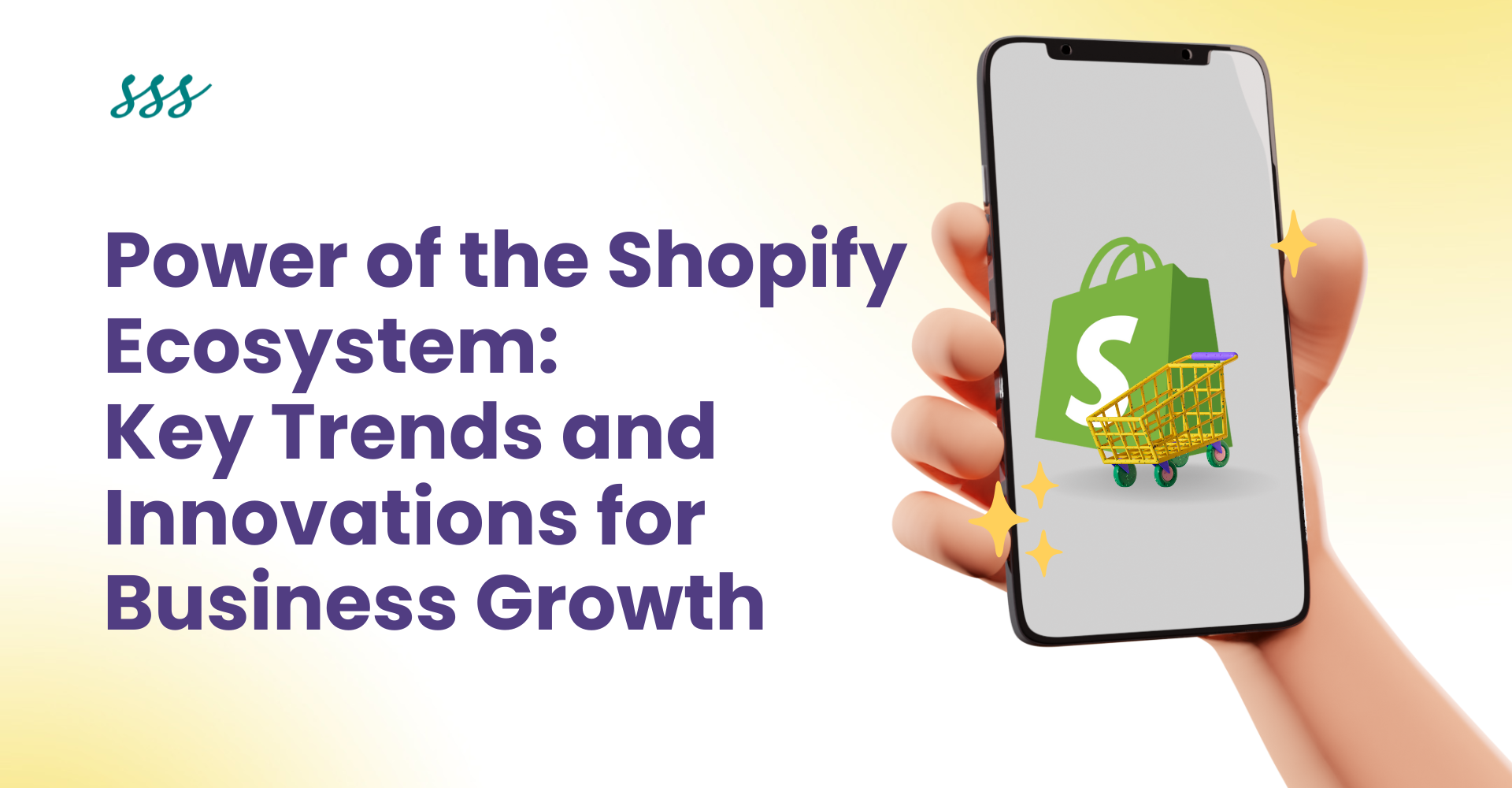
Power of the Shopify Ecosystem: Key Trends and Innovations for Business Growth
The Shopify ecosystem has transformed the way businesses operate online, offering a powerful platform that enables merchants to scale and succeed in the competitive e-commerce landscape. From small startups to global brands, Shopify provides an extensive suite of tools, integrations, and services designed to simplify online selling, enhance customer experience, and drive growth. As e-commerce continues to evolve, Shopify stays ahead by introducing innovative features that cater to changing consumer behaviors and technological advancements.
In recent years, Shopify has expanded beyond a simple online store builder to a full-fledged commerce ecosystem, integrating AI-driven automation, headless commerce, social selling, and advanced checkout experiences. Businesses leveraging these innovations can streamline operations, boost conversions, and create seamless, personalized shopping journeys for their customers.
Moreover, Shopify’s commitment to sustainability, multichannel selling, and B2B commerce highlights its role as a future-ready platform. Entrepreneurs and enterprises alike are tapping into Shopify’s latest trends, such as augmented reality (AR), one-click payments, and AI-powered product recommendations, to stay ahead of the competition.
This article explores the power of the Shopify ecosystem by delving into the key trends and innovations that are driving business growth. Understanding these developments can help merchants unlock new opportunities and build a more resilient, scalable e-commerce strategy.
The Evolution of the Shopify Ecosystem
Shopify began as a simple e-commerce platform in 2006, designed to help small businesses create online stores with ease. Over the years, it has evolved into a comprehensive ecosystem that supports businesses of all sizes, offering everything from website building tools to advanced payment processing and marketing automation.
One of the key milestones in Shopify’s evolution was the introduction of the Shopify App Store, which allowed developers to create and integrate third-party applications, enhancing store functionality. The launch of Shopify Payments simplified transactions, while Shopify Plus provided enterprise-level solutions for scaling brands. The addition of multichannel selling capabilities enabled merchants to seamlessly sell across social media, online marketplaces, and brick-and-mortar stores.
Today, Shopify continues to innovate with AI-powered features, headless commerce, and tools for B2B transactions. The platform has also expanded its ecosystem to include fulfillment services, POS systems, and sustainability initiatives, reinforcing its commitment to supporting merchants at every stage of growth.
As the e-commerce landscape evolves, Shopify remains at the forefront, continuously introducing new technologies to help businesses thrive. Its ever-growing ecosystem ensures that merchants have the tools they need to stay competitive and meet the demands of modern consumers.
10 Key Trends in the Shopify Ecosystem
Here’s a detailed article on 10 Key Trends in the Shopify Ecosystem.
1. AI and Automation in Shopify
Artificial intelligence (AI) and automation are revolutionizing e-commerce, and Shopify is at the forefront of this transformation. With AI-powered features like Shopify Magic, merchants can generate product descriptions, automate customer support, and personalize recommendations based on user behavior.
AI-driven chatbots and virtual assistants streamline customer interactions, enhancing engagement and reducing response times. Additionally, automation tools simplify order management, inventory tracking, and email marketing, allowing businesses to focus on growth rather than manual tasks. As AI technology continues to evolve, Shopify’s ecosystem will integrate even more advanced tools to help merchants optimize their operations and deliver exceptional shopping experiences.
2. Headless Commerce and Custom Storefronts
Headless commerce is gaining traction as businesses seek more flexible and customized shopping experiences. Shopify enables headless commerce by decoupling the frontend from the backend, allowing developers to create unique storefronts tailored to specific needs.
With Shopify’s tools, merchants can design fast-loading, immersive shopping experiences without being constrained by traditional templates. This trend is particularly beneficial for brands aiming to provide seamless omnichannel interactions across web, mobile, and social media platforms. As e-commerce continues to evolve, headless commerce will play a crucial role in enhancing performance, scalability, and user experience on Shopify stores.
3. Social Commerce and Multichannel Selling
Shopify’s integration with major social media platforms like Facebook, Instagram, TikTok, and Pinterest has made multichannel selling more accessible than ever. With built-in tools for seamless product tagging and in-app checkout experiences, merchants can directly sell to customers where they spend most of their time. Social commerce enhances brand visibility and boosts engagement, making it a key strategy for businesses looking to expand their audience.
Shopify’s partnerships with marketplaces like Amazon and Walmart ensure that businesses can diversify their sales channels and maximize revenue. The increasing reliance on social commerce highlights the importance of engaging content, influencer collaborations, and data-driven marketing strategies for success.
4. Sustainability and Ethical E-commerce
Consumers are becoming more conscious of their environmental impact, and Shopify is helping businesses meet this demand with sustainable solutions. Shopify’s Planet initiative allows merchants to track and offset their carbon emissions, while partnerships with eco-friendly suppliers encourage sustainable product sourcing. Many brands now prioritize ethical manufacturing, recyclable packaging, and carbon-neutral shipping as part of their business model.
This trend reflects a broader shift toward corporate social responsibility, with sustainability becoming a competitive advantage rather than a niche consideration. As consumer expectations grow, Shopify will continue to innovate in this space, helping merchants build responsible and future-proof businesses.
5. Shopify Payments and Checkout Optimization
A seamless checkout experience is crucial for e-commerce success, and Shopify Payments is leading the way in optimizing payment processes. Features like Shop Pay, one-click checkout, and local currency support reduce cart abandonment and improve conversion rates.
The introduction of Buy Now, Pay Later (BNPL) options enhances customer flexibility, driving higher purchase values. Shopify’s fraud prevention tools and encrypted transactions also ensure secure payments, boosting consumer confidence. As online shopping habits continue to shift, Shopify is investing in even more innovations, such as biometric authentication and cryptocurrency payments, to make the checkout process faster, safer, and more efficient.
6. B2B on Shopify
Shopify is no longer just for direct-to-consumer (DTC) brands; it is increasingly catering to business-to-business (B2B) commerce as well. With features like custom pricing, bulk ordering, and wholesale storefronts, Shopify makes it easier for businesses to manage B2B transactions alongside their retail operations.
The platform’s integration with enterprise resource planning (ERP) systems enables seamless inventory and supply chain management, enhancing efficiency for large-scale businesses. As more wholesalers and manufacturers shift online, Shopify’s commitment to B2B functionality will become an essential factor in its ecosystem’s growth. This trend highlights the growing importance of digitization in the wholesale industry.
7. Shopify Plus for Enterprise Growth
Shopify Plus has emerged as a powerful solution for large enterprises looking to scale their online presence. With features like automation workflows, advanced analytics, and personalized customer experiences, Shopify Plus caters to high-volume businesses seeking efficiency and scalability. Brands like Gymshark and Allbirds leverage Shopify Plus to manage global operations while maintaining fast and secure transactions.
The platform’s robust API support allows seamless integration with third-party tools, giving businesses the flexibility to customize their e-commerce ecosystem. As enterprises increasingly turn to Shopify Plus for digital transformation, its continuous innovation will further strengthen its position as a leader in enterprise commerce.
8. Augmented Reality (AR) and 3D Product Visualization
Augmented Reality (AR) and 3D product visualization are transforming the online shopping experience by bridging the gap between digital and physical retail. Shopify enables merchants to integrate AR and 3D models into their product pages, allowing customers to interact with products in a lifelike manner before making a purchase. This trend significantly reduces return rates and increases buyer confidence, particularly in industries like fashion, furniture, and electronics.
As technology advances, AR shopping experiences will become even more immersive, with virtual try-ons and in-home previews becoming standard features. Shopify’s investment in AR underscores the importance of innovation in driving customer engagement and sales.
9. Subscription-Based E-commerce and Membership Models
Subscription commerce is on the rise, and Shopify is making it easier for businesses to adopt this model. Whether it’s subscription boxes, digital memberships, or recurring services, Shopify’s ecosystem supports various subscription-based business models through dedicated apps and integrations. The convenience of automated recurring payments ensures customer retention and predictable revenue streams for merchants.
As consumer preferences shift toward long-term value and personalized experiences, subscription services will continue to thrive. Shopify’s support for membership-based e-commerce reflects a broader industry trend, emphasizing customer loyalty, personalized content, and seamless payment solutions.
10. International Expansion and Cross-Border Selling
Shopify is helping businesses expand beyond local markets with features designed for cross-border selling. Tools like Shopify Markets enable merchants to manage multiple currencies, languages, and localized pricing strategies with ease. Integrated tax and duty calculators simplify international transactions, ensuring compliance with global trade regulations.
Shopify’s partnerships with logistics providers streamline global shipping, making international e-commerce more accessible than ever. As businesses seek growth opportunities in new regions, Shopify’s commitment to international commerce will play a pivotal role in shaping the future of cross-border retail. This trend highlights the growing demand for global scalability and localization in e-commerce.
Why Businesses Should Leverage Shopify’s Evolving Ecosystem for E-Commerce Growth
Shopify’s evolving ecosystem offers businesses a powerful platform to scale efficiently with cutting-edge tools, seamless integrations, and AI-driven features. From enhanced customization to advanced analytics, Shopify constantly innovates to improve online selling. Businesses can leverage its ecosystem to optimize storefronts, enhance user experiences, and boost conversions. With built-in SEO tools, multi-channel selling, and secure payment gateways, Shopify simplifies e-commerce operations.
Partnering with the best Shopify development company in India ensures tailored solutions, seamless app integrations, and expert guidance to maximize Shopify’s capabilities. As Shopify expands with automation, AI recommendations, and headless commerce, businesses that adapt early gain a competitive edge. Whether launching a new store or upgrading an existing one, tapping into Shopify’s evolving ecosystem unlocks limitless growth opportunities. Stay ahead in the e-commerce game by utilizing Shopify’s innovations with expert developers.
Conclusion
The Shopify ecosystem is constantly evolving, driven by technological advancements and changing consumer expectations. From AI-powered automation and headless commerce to social selling and sustainability, these key trends are shaping the future of online retail. Businesses that leverage these innovations can enhance customer experiences, streamline operations, and achieve sustainable growth in the competitive e-commerce landscape. As Shopify continues to expand its ecosystem, merchants should stay informed about emerging trends to capitalize on new opportunities and stay ahead of the curve.


